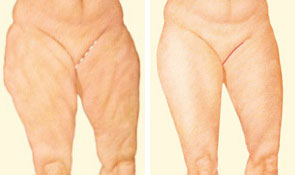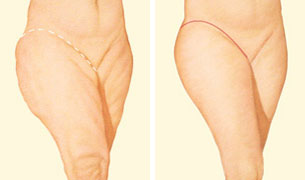What is a Thigh Lift?
Thigh lift surgery reshapes the thighs by reducing excess skin and fat, resulting in smoother skin and better-proportioned contours of the thighs and lower body.
If fitness and weight control efforts have not achieved your goals for a body that is firmer, more youthful-looking and more proportionate to your overall body image, a surgical lift may be right for you.
What thigh Lift surgery can't do
Thigh lifts are not intended strictly for the removal of excess fat. Liposuction alone can remove excess fat deposits where skin has good elasticity and is able to naturally conform to new body contours.
In cases where skin elasticity is poor, a thigh lift along with liposuction may be recommended.
Thigh lift candidates
In general, candidates for a thigh lift are:
- People whose weight is relatively stable
- Individuals with excess soft tissue along the inner (medial) thigh region and/or the outer (lateral) thigh
- Healthy individuals who do not have medical conditions that impair healing or increase risk of surgery
- Nonsmokers
- Individuals with a positive outlook and realistic goals for what thigh lift surgery can accomplish
- Individuals committed to leading a healthy lifestyle, including proper nutrition and fitness
Thigh Lift recovery
During your recovery from thigh lift surgery, dressings/bandages may be applied to your incisions following the procedure.
Small, thin tubes may be temporarily placed under the skin to drain excess fluid or blood that may collect.
You will be given specific instructions that may include:
- How to care for the surgical site(s)
- Medications to apply or take orally to aid healing
- Specific concerns to look for at the surgical site or in your general health
- When to follow up with your plastic surgeon
Be sure to ask your thigh lift surgeon specific questions about what you can expect during your individual recovery period:
- Where will I be taken after my surgery is complete?
- What medication will I be given or prescribed after surgery?
- Will I have dressings/bandages after surgery? When will they be removed?
- Are stitches removed? When?
- When can I resume normal activity and exercise?
- When do I return for follow-up care?
Thigh lift recovery at home
If you experience any shortness of breath, chest pains or unusual heartbeats, seek medical attention immediately. Should any of these complications occur, you may require hospitalization and additional treatment.
Following your physician's instructions is key to the success of your surgery.
It is important that the surgical incisions are not subjected to excessive force, swelling, abrasion or motion during the time of healing. Your doctor will give you specific instructions on how to care for yourself.
Thigh lift results
The results of a thigh lift are visible almost immediately. However, it may take several months for the final results to fully develop.
Following a thigh lift, skin quality is improved both in appearance and feel.
Some visible scars will remain, but the overall results are long lasting, provided that you maintain a stable weight and general fitness.
As your body ages, it is natural to lose some firmness. However, most of your initial improvement should remain.
Although good results are expected from your procedure, there is no guarantee. In some situations, it may not be possible to achieve optimal results with a single surgical procedure and another surgery may be necessary.
Thigh lift procedure steps
A thigh lift procedure includes the following steps:
Step 1 – Anesthesia
Medications are administered for your comfort during the surgical procedures. The options include intravenous sedation and general anesthesia. Your doctor will recommend the best option for you.
Step 2 – The incision
Incision patterns vary based on the area or areas to be treated, degree of correction and patient and surgeon preference.
Inner thigh lift incision
One technique used for a thigh lift places incisions in the groin, extending downward and wrapping around the back of the thigh.
Another technique removes excess skin from the groin down to the knee using an incision along the inseam.
You may also qualify for a minimal incision inner thigh lift that involves an incision only in the groin area. Your plastic surgeon will determine what's appropriate.

Outer thigh lift incision
Improving the contours of the outer thigh may require an incision extending from the groin around the hip and across the back.
Advanced techniques usually allow incisions to be placed in strategic locations where they can be hidden by most types of clothing and swimsuits. However, incisions may be extensive.

Step 3 – Closing the incisions
Deep sutures within underlying tissues help to form and support the newly shaped contours. Sutures, skin adhesive tapes or clips may be used to close the skin incisions.
Step 4 – See the results
The smoother tighter contouring that results from a thigh lift is apparent almost immediately, although initially obscured by swelling and bruising. Get more information about thigh lift results.>
Thigh lift risks and safety
The decision to have plastic surgery is extremely personal, and you'll have to decide if the benefits will achieve your goals and if the risks and potential complications of thigh lift surgery are acceptable.
Your plastic surgeon and/or staff will explain in detail the risks associated with surgery. You will be asked to sign consent forms to ensure that you fully understand the procedure and any risks and potential complications.
Possible thigh lift surgery risks include:
- Anesthesia risks
- Poor wound healing
- Bleeding
- Infection
- Fluid accumulation (seroma)
- Major wound separation
- Asymmetry
- Deep vein thrombosis, cardiac and pulmonary complications
- Fatty tissue under the skin might die (fat necrosis)
- Persistent pain
- Skin discoloration and/or swelling
- Skin loss
- Sutures may spontaneously surface through the skin, become visible or produce irritation that require removal
- Unfavorable scarring
- Numbness or other changes in skin sensation
- Recurrent looseness of skin
- Possibility of revisionary surgery
These risks and others will be fully discussed prior to your consent. It's important that you address all your questions directly with your plastic surgeon.
Your thigh lift surgery consultation
During your thigh lift surgery consultation be prepared to discuss:
- Your surgical goals
- Medical conditions, drug allergies and medical treatments
- Current medications, vitamins, herbal supplements, alcohol, tobacco and drug use
- Previous surgeries
Your plastic surgeon will also:
- Evaluate your general health status and any pre-existing health conditions or risk factors
- Examine and measure your body, including detailed measurements
- Take photographs for your medical records
- Discuss your options
- Recommend a course of treatment
- Discuss likely outcomes of thigh lift surgery and any risks or potential complications
The success and safety of your procedure depends on your complete candidness during your consultation.
Be sure to ask your plastic surgeon questions. To help, we have prepared a checklist of questions to ask your thigh lift surgeon that you can take with you to your consultation.
It's very important to understand all aspects of your thigh lift procedure. It's natural to feel some anxiety, whether it's excitement for your anticipated new look or a bit of preoperative stress. Don't be shy about discussing these feelings with your plastic surgeon.
Preparing for thigh lift surgery
In preparing for thigh lift surgery, you may be asked to:
- Get lab testing or a medical evaluation
- Take certain medications or adjust your current medications
- Stop smoking
- Avoid taking aspirin, anti-inflammatory drugs and herbal supplements or other medications that may increase bleeding
Thigh lift surgery may be performed in an accredited office-based surgical facility, licensed ambulatory surgical center or a hospital.
If your thigh lift is performed on an outpatient basis, be sure to arrange for someone to drive you to and from surgery and to stay with you for at least the first night following surgery.